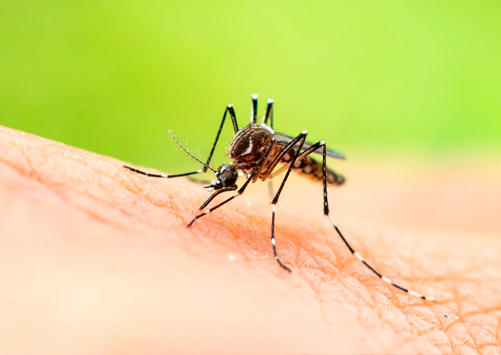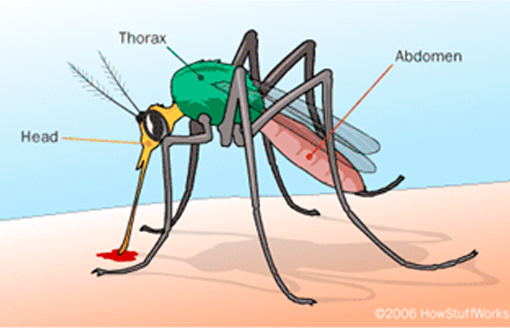Mosquitoes are small, delicate members of the Order Diptera, which as adults have piercing and sucking mouth-parts. They constitute the Family Culicidae, which in Australia is represented by just over 270 described species. The blood-sucking habit of the female has given the group significant pest status, which is mostly manifest in the way in which they may affect the health and comfort of humans and livestock. While much annoyance and irritation is attributable to mosquitoes, in the worldwide context these insects have claimed, and continue to claim, untold numbers of human lives by the efficient biological transmission of a variety of diseases.


Structure
Adult mosquitoes are usually about 3-6 mm long, slender, long-legged, narrow-winged and equipped with piercing and sucking mouthparts. Larvae are aquatic and have a well-developed head, a pair of spiracles located at the hind end and a body often covered with tufts of bristles. Pupae appear oval-shaped with a tail-like abdomen.
Life cycle
Females require a blood meal before egg production. Eggs are usually laid on the surface of water (fresh, brackish or saline, depending on the species) or on surfaces that will be wetted (eg flood plains). The larvae, often called 'wrigglers', are aquatic and feed on organic matter filtered from their environment. They usually undergo 4 moults after which they pupate. The pupa is often called a 'tumbler', does not feed but is quite mobile. The adult emerges from the pupal case on the surface of undisturbed water. The life cycle may be complete within a week but may be much longer, depending on tem-perature, food, species and other factors. Adult males are short-lived and feed mostly on honeydew, nectar or other plant secretions. Adult females may live for several weeks and may pierce the skin of a variety of animals in order to suck blood.
Mosquitoes as pests
Mosquitoes pose a significant threat to the health and com-fort of humans and livestock.
The term 'biting' is widely applied to the piercing and sucking feeding action of adult female mosquitoes. This habit can be so annoying and irritating that it can reduce livestock yield. Humans, too, may suffer mild to severe irritation. Ht.1st-finding, probably relies largely on the detection of warmth, moisture and carbon dioxide in the atmosphere. Certain colours may, in some cases, be more attractive than others, and subtle chemical presence (eg sweat components) may also play a role. Irritation from bites arises from the injection of saliva into the skin. The saliva comprises mainly proteins / peptides, which may serve anticoagulant and anaesthetic functions. Humans vary in their response to the injection of such foreign substances, and desensitisation may occur.
The importance of the role that mosquitoes play in the transmission of diseases cannot be overstated. Millions of human lives have been lost to diseases distributed and trans-mitted by adult female mosquitoes. The more dangerous dis- eases transmitted by mosquitoes rely on biological transmission. Here, the female receives a disease-infected blood meal, the disease-causing organisms multiply within her body, and at some later stage she injects the disease organisms into a new host. The types of diseases transmitted by mosquitoes include:
- Protozoan- type diseases (eg malaria);
- nematode (round worm)-type diseases (eg: filariasis); and
- Virus-type diseases (eg Ross River virus, Murray Valley encephalitis virus). In Australia, mosquitoes have been responsible for the trans-mission of a range of diseases in humans:
Malaria
Malaria involves the transmission of certain parasitic protozoans (Plasmodium spp.) to humans by Anopheles mosquitoes. This disease, which causes severe fever and sometimes death, now occurs only occasionally in Australia. Travellers who are already infected and enter Australia appear to be the source of local infections.
Dengue
The Dengue virus also seems to be sourced from travellers entering Australia who are already infected with the virus. The disease is transmitted by Aedes aegypti and infected humans suffer muscle and joint pains and fever. Death may result.
Ross River virus and Barmah Forest virus
These viruses are transmitted by a range of mosquito hosts. Infection in humans can cause Polvarthritis, a disease which can result in severe debilitation for periods varying from months to years.
Murray Valley encephalitis virus, Kunjin virus and Japanese encephalitis virus
These viruses cause encephalitis in humans and this may result in brain damage or death. Culex annulirostris appears to be the main vector